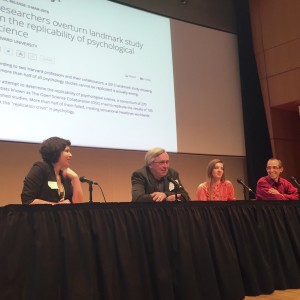
Developing the power of discernment
By Nate Rabner
Science journalists often face a dilemma: Newsworthiness is key to bringing in readers, but the pursuit of newsworthiness above accuracy or context is a recipe for disaster. Minding both elements can be difficult in science journalism, where progress far more often occurs incrementally than through large, headline-grabbing leaps.
In the session “Being a discerning reporter” at DCSWA’s 2016 Professional Development Day, a panel of writers and editors offered tips for navigating this challenge, finding stories that matter and getting them right.
Misinterpreted statistics
Science News managing editor and blogger Tom Siegfried presented a “recipe for wrong science”: a new development in a hot field that claims to overturn previous beliefs – otherwise known as a big scoop for a science journalist.
His first key to avoiding these stories is understanding p-values and confidence intervals. These statistical measures can be unreliable, Siegfried warned: A p-value, which compares observed results to modeled predictions, can be “a substitute for thought where thought is actually very important,” he said, helping poorly constructed studies make their way to journals and from there to your news feed.
Misrepresented findings
Even if a study yields well-supported conclusions, it’s still vulnerable to manipulation by others, panelists warned. Will Saletan, a senior reporter at Slate, spoke about his experience reporting on genetically modified organisms, or GMOs, a field rife with disingenuous critics.
To tell legitimate concerns from unfounded gripes, he said, journalists should “make the merchants of doubt put forward a hypothesis” and take a turn defending a factual assertion for a change. He also recommended using “control groups” to expose double standards, as when he picked apart the criticism that the pesticide Bt in GMO crops is dangerous: “Really?” he asked. “’Cause there’s an organic Bt spray that all your organic farmers use.”
Exaggerated impacts
The final place a story can be distorted is on a reporter’s or editor’s computer. Julie Beck, a senior associate editor at The Atlantic, reminded the journalists in attendance that it’s important not to force a conclusion onto an inconclusive study – even if you’re writing a 5,000-word feature about it. “A lot of times in science journalism, there is a pressure to … say, ‘Science says blah,’” she said. “A lot of times that is not the case – there is no clear answer,” whether because the answer hasn’t been found yet, researchers don’t agree on it, or the answer is ultimately unknowable.
Beck also shared her research process: Comb through Google, abstracts and books to compile a mass of notes, then “gargle on the sea of studies and then spit out something that you hope is helpful.” Learning the history behind a study reduces the risk of ignoring precedent, and comparing methodologies can demystify seemingly surprising findings.
Taking the time you need
All these tactics contribute to averted embarrassment. Moderator Rachel Gross, a Slate editorial assistant, recalled Open Science Collaboration’s recent psychology reproducibility project, which led media to call the field’s credibility into question, only to be criticized by scientific responses that were themselves misrepresented. Getting the story right is worth the time it takes, she concluded. “Don’t cover science as breaking news, is what I learned.”

Sorry, comments are closed for this post.